
Buxton Local History Society



Research projects
The Society is happy to undertake small research projects on behalf of people who have connections with the town or who have visited and been curious about some aspect of it’s past. The following are brief summaries of enquiries received . UPDATED March 24.
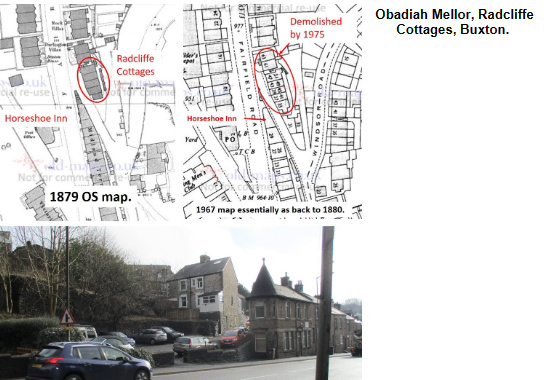
Radcliffe Cottage is actually ‘cottages’, a group of eight, three roomed dwellings built on the back-to-back design. However, looking at the site now, they may have been like maisonettes with the upper floor home accessed from the terrace behind. They are shown on the 1879 OS map but their actual building date is unknown. They were located on the east side of Fairfield Road, behind what was then the Horse Shoe Inn, just above the junction with Lightwood Road. The 1879 map also shows a row of tiny buildings which I guess were privies.
By 1897, the next OS revision, a pair of semi-detached houses had been built to the south of Radcliffe Cottages and facing south.
The 1901 census lists Obadiah as living next-door-but-one from the Horse Shoe Inn. However, the Buxton Directory for 1908 lists him at No.39 whereas the Horse Shoe was No.29.
The 1967 map of the area brings an explanation for this. The council has deemed the new houses to be on Fairfield Road whereas the census enumerator obviously considered them to be on Windsor Road. The census listing, which usually went from house to house, thus misses Nos.31, 33 & 35, which seems to have been added after 1901, placing 39 only one address away from 29.
By the next OS survey in 1975 Radcliffe Cottages have been demolished, probably as unfit for habitation, perhaps not unsurprisingly, and have become a car parking area.
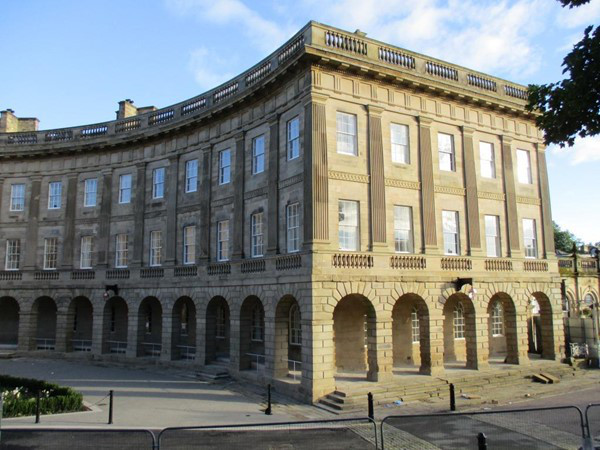
I am transcribing of some letters written within the Clulow family between 1780 and 1820. On 10 Aug 1812, Mary Ann Clulow wrote to her sister Elizabeth c/o Mrs. Halls, Great Hotel, Buxton. Where was the hotel and does it still exist?
The Crescent comprised two hotels, St Ann’s at the west end and The Great Hotel at the east end. This included the Assembly Room with its Adams style ceiling. In addition, there were originally several lodging houses, and in the centre, a town house for the Duke of Devonshire himself. Soon the hotels were to expand towards the centre of the Crescent, progressively absorbing these individual dwellings. Philip Moore was the last tenant of the Great Hotel and by 1854 it was converted into three lodging houses. In 1868, John Smilter reconverted the three properties into a hotel and named it the Crescent Hotel, which survived into the 1930s when it was converted into offices, a clinic and public library. The whole of the crescent is now the Buxton Crescent Spa Hotel.

I am in possession of an American baseball with the handwritten inscription 'PEAK HOSPITAL BASEBALL TEAM, RUNNERS UP, BUXTON LEAGUE 1918'. My mother thinks it may have been connected with a visiting American baseball team.
During the 1914 – 18 war the Canadian Army Medical Corps established a hospital in The Granville Hotel, Ramsgate, Kent. However, in 1916 this this was bombed by the Germans. Casualties were minimal but it was decided that it was too dangerous to remain. Buxton already had the Canadian Discharge Depot (C.D.D.) in The Empire Hotel, and with other large hotels available they moved to this “safe area” in late 1917. The main one was the Spa Hotel on Broadwalk, which they called the “Granville Special Hospital”, and they also took over the Palace and the Peak Hydro, now the museum, plus other smaller buildings. As the men recovered, keeping them active, busy, and entertained was important. Among many other activities a Baseball league was established. Four teams were involved, one from each of the hospitals and was won by the C.D.D with the Peak Hydro second.

I am undertaking some research into North Western Road Car Co., and its predecessor British Automobile Traction Co., bus garages in Buxton.
The first garage was BAT’s in Holmfield, then called Brittany, in Burbage in 1923-26. This was next to the White Lion public house where the two new houses are at the Leek Road end. The next garage was North Western’s in Charles Street in an old mill building which is now Buxton Building Supplies shop, they also had a booking office on Eagle Parade. This was where the Italian restaurant Firenze was for many years and later the Greek restaurant Ithaca. The last garage, now Trent, was where Aldi’s store is on Station Road. The bus depot is now in Dove Holes.
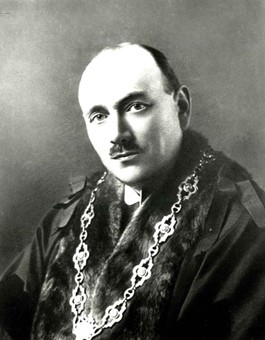
I am currently researching my ancestors. William Fenwick Mill Snr was married to Ann Lawson (my ancestor). I believe William Fenwick Mill Jnr was Mayor of Buxton in 1918 and that they both owned/managed the George Hotel.
William Snr was born near Redruth, Cornwall in 1835, the son of a blacksmith, but became a teacher. In 1860 William married Hannah Mill and took up a teaching post at Habergham Eaves, Burnley. After the birth of their third child in 1865 he came to Buxton as headmaster of the college when it was on the corner of Market/South Street, in the building now Print Express. Hannah died soon after the move and William married Ann Lawson, which brought him into contact with Brian Bates of Old Hall Hotel, and his family. William and Ann had a son, William Fenwick jnr. and a daughter. By 1881 William had given up teaching and let furnished apartments at Carlisle House on Broadwalk, and became secretary of the Buxton Improvements Co., who built and ran the glass Pavilion and concert hall. These changes doubtless involved the Bates family and by the end of the 1880s he was tenant of the George Hotel. William died in 1897 and William jnr. took over the hotel. He became Chairman of the Urban District Council; Councillor for the North Ward; and, in 1918, he was elected the first Mayor of Buxton, serving two terms. St. James church on Bath Road contained windows to the memory of both father and son but, despite requests by the family, were not saved when the church was demolished.
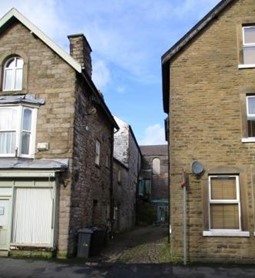
On a recent visit to Buxton, my wife and I spotted the street sign for Primitive Court. Was there a Primitive Methodist chapel or meeting house at the Court?
The earliest references to a Primitive Methodist meeting place name variously, Hobson’s Yard, Back Lane, behind the Queen’s Inn, and a cottage at the top of Bath Street. George Hobson, farmer and landlord of the Queen’s Inn, had a yard and stabling at the top of Bath Street. Although South Street is called Back Lane in some documents, we can conjecture that this term could refer to any lane serving the rear of terraced premises. On that basis it seems safe to assume the early meeting place was in or around Hobson’s Yard at the top of Bath Street, now Bath Road.
Picture: The entrance to Hobson’s Yard, not to be confused with Hobson’s Court next to Bargain Booze.

On a recent Backstage Tour of the Buxton Royal Opera House we were informed that a rail line used to carry coal supplies to the building and, moreover, that this line is still extant but hidden below the W H Smith’s shop in the Springs Shopping Centre. My research on Buxton’s railways makes no reference to such a line.
The Opera House’s use of coal would probably amount to perhaps one ton per week. A railway coal wagon in 1904 would hold either 8 or 10 tons, thus a tunnel to deliver 6-8 wagons per year would not be justified. Even if it was economically viable a route under the precinct would be longer than beneath George Street, an almost straight line from station to Opera House, and would need to pass beneath the river twice, thus being much deeper underground that the basement of WH Smith’s. However, the basement of Winster Place was semi-circular brick arches and would resemble a tunnel. The cellars of Old Hall were of similar construction, see picture.
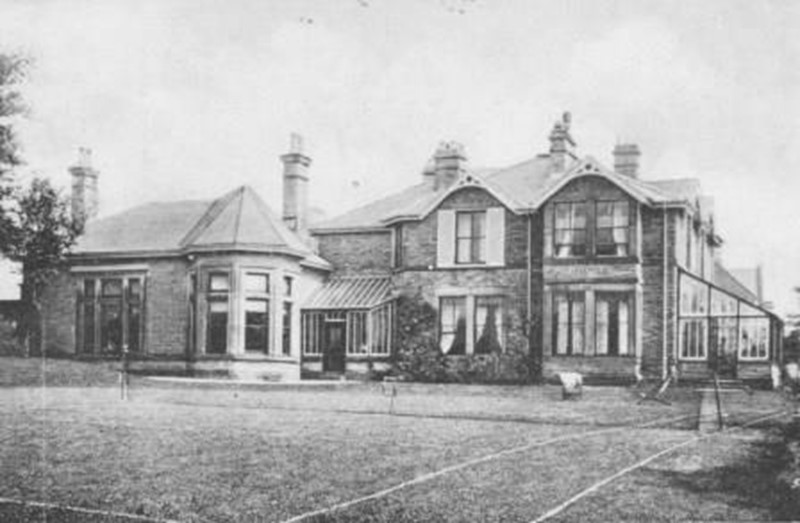
I contact you from Belgium. I am busy collecting info for a future book concerning the life of a friend of the family who spent the WW2 as a refugee in England without his parents in the Belgian College, Buxton, from 1942 till 1945.
With the occupation of Belgium by the Nazis the Belgian Government in Exile established four schools for refugee children. The Grange Girls School in Park Road was taken over in December 1940 under the headship of Father V R De Meyer and housed about 80 boys. There were about 20 teachers to cope with the problem of needing both French and Flemish as well as English. The boys could use a laboratory at Buxton College one afternoon a week and formed both a scout troop and an ATC unit. The school closed in 1945 and the girl’s school reopened but only for a year. The building remained vacant and was demolished in the 1970s, being replaced with new houses, only the gate posts remaining.
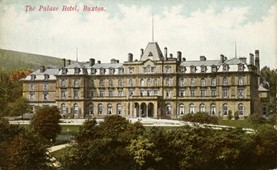
My father spent all his working life in the Civil Service, working for the Inland Revenue. However, during all or most of the war years he worked in Buxton. Was there any particular reason for him moving to Buxton?
During WW2 Buxton was considered a “safe” town, unlikely to be bombed, which proved correct. The large hotels were idea for use as offices for vital organisations needing to be removed from London and other target cities. The Inland Revenue, now HMRC, took over the Palace Hotel and had about 800 staff there. Some may have been accommodated in the hotel but most were lodged about the town.

I am trying to ascertain the approximate year that the estate around Sherwood Road, Buxton was built? The type of housing indicates mid to late 1960’s, but I cannot find any further information.
The estate is older than the 1960s. The Ordinance Survey map for 1925 shows open fields but that for 1938 shows a large part of the estate covering Sherwood Road, numbers up to 54, along with Aldwark, Derwent, Forrest, Welbeck roads and Grove Lane. Sherwood was completed by 1948 and Oaklea by 1950. The style of the houses is similar but there are detail changes in the post-war building. Pictured is one of the main pre-war types. These seem a slightly odd design in that the waste pipes on the outside indicate the bathroom is on the front of one half and the back on the other.

Who was W H Salt who sold a collection of Romano-British pewter ware to the British Museum in 1927?
William Henry Salt was the eldest son of Micah Salt, who excavated many caves and barrows around Buxton. William continued with his father’s tailoring business at 48 High St. but did not seem to have carried on with excavations after Micah’s death.
William was a founder member of the Buxton Archaeological & Natural History Society.
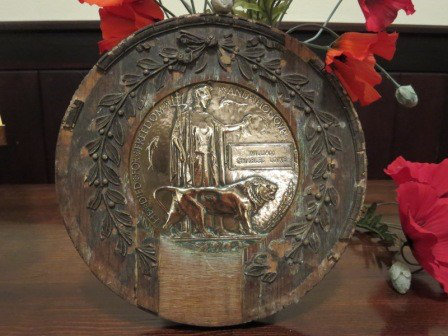
What is the origin of this memorial plaque from the First World War?
The central plaque is about 5 inches in diameter, bronze, and was awarded to the next of kin to servicemen killed in the war. Known as the “Dead Man’s Penny” many relatives could not be traced and thus did not receive them. Each has the casualty’s name, in this case William Charles Lowe from Taxal, killed 23rd March 1918, and the inscription “He died for freedom and honour”.
The wooden surround is a later addition.
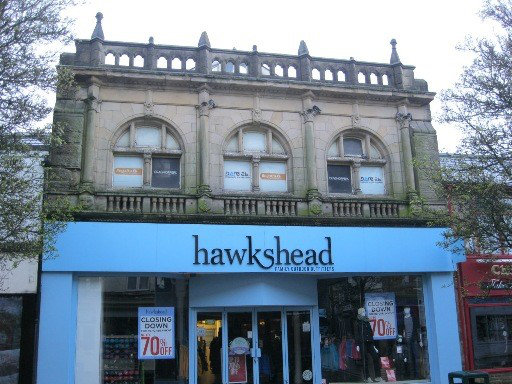
What was the Hawkshead store, Spring Gardens, originally?
The building was erected in 1902 for Joshua Burton as a grocers, confectioners, wine merchants and hardware shop known as Burton’s Stores. It also occupied two adjacent small shops. It was not over successful and slowly contracted to the main building. The business was transferred to Burgons in late 1938 and the building taken over by Timothy, Whites & Taylors.

My mother lived at 3 Bentley Cottages, Harpur Hill in the 1930s but I cannot find it on Google.
Bentley Cottages were and still are two terraces of six houses on the side of a lane on the southern edge of Harpur Hill, together with a terrace of eighteen called Haslin Row and locally known as Long Row. In 1956 the lane was named Haslin Road but after 1970 the Haslin Row cottages were demolished leaving only what had been Bentley Cottages.
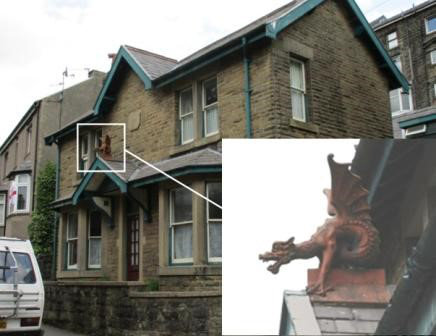
My daughter has just purchased a house in Nunsfield Road. It has a stone on the front reading ‘Bradwell Villa 1901’ and the garage behind it may have been stables for horses for a coal merchant.
Jethro Bradwell was a coal carter based in Hogshaw coal yard. Jethro died 1912 aged 70 and his son, Walter, had the house until c.1923 when he moved into Coronation Cottages, next door.
The finial, the main point of interest and one of a pair, came from 48 High St., William Salt’s shop. The other was on Foxlow Lodge until 2016 but has gone with reroofing.

My grandfather’s half sister married successively two livery stable operators in Buxton, William Barson (in 1876) and Charles Knowles Sykes (in 1902). Family folk lore has it that Sykes was quite a large- scale operator in Buxton.
William Barson was a coach proprietor but later had the livery stables at the east end of Spring Gardens. He died in 1897 and in 1902 his widow married Charles Sykes, an “Agent for Hargreave’s Dyers”, a travelling salesman. Under Sykes the business became a motor garage but did not prosper. It moved first to behind the Shakespeare Hotel, then Wye St., and was bankrupt in 1933.
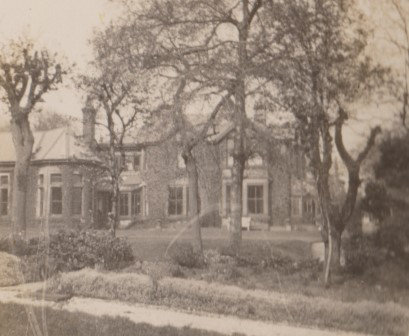
I’m trying to find the location of The Grange in Buxton. My mother was evacuated to the town during WW2 and I have a number of pictures labelled The Grange. She worked for HM Customs and Excise.
The Grange was a girl’s boarding school in Park Road, operating from about 1900 to 1939 when it closed and became a school for refugee boys from Belgium until 1945. It reopened after the war but lasted only to the summer of 1949. The building was demolished in the 1970s.
The evacuated Customs & Excise took over the Palace Hotel as offices with some 800 staff.

I was born in the Croft Nursing home Buxton in 1946. I would like to know if it still exists.
No record of The Croft could be found in local directories or in the Buxton Advertiser and the only likely premises are Croft House, West Road or The Croft, Macclesfield Road. However a search of Electoral Registers showed that The Croft, 12 Macclesfield Road was the correct building and that it closed as a nursing home in c.1951 to become a residential guest house and later flats.
To return to the main "Projects" page CLICK HERE